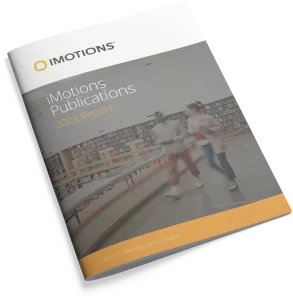-
Exploring Preservice Teachers’ Emotional Experiences in an Immersive Virtual Teaching Simulation through Facial Expression Recognition
This study investigated preservice teachers’ emotional experiences while interacting within a virtual scenario-based teacher-training system called Simulation for Teaching Enhancement of Authentic Classroom behavior Emulator (SimTEACHER). We created three types of interactions (no interaction, unexpected interaction, and expected interaction) within SimTEACHER and examined the influences of the interaction design on preservice teachers’ emotional responses in […] -
How Are Students’ Emotions Associated with the Accuracy of Their Note Taking and Summarizing During Learning with ITSs?
Abstract: The goal of this study was to examine 38 undergraduate and graduate students’ note taking and summarizing, and the relationship between emotions, the accuracy of those notes and summaries, and proportional learning gain, during learning with MetaTutor, an ITS that fosters self-regulated learning while learning complex science topics. Results revealed that students expressed both […] -
How Are Students’ Emotions Associated with the Accuracy of Their Note Taking and Summarizing During Learning with ITSs?
Abstract: The goal of this study was to examine 38 undergraduate and graduate students’ note taking and summarizing, and the relationship between emotions, the accuracy of those notes and summaries, and proportional learning gain, during learning with MetaTutor, an ITS that fosters self-regulated learning while learning complex science topics. Results revealed that students expressed both […] -
Game Scenes Evaluation and Player’s Dominant Emotion Prediction
Abstract: In this paper, we present a solution for computer assisted emotional analysis of game session. The proposed approach combines eye movements and facial expressions to annotate the perceived game objects with the expressed dominate emotions. Moreover, our system EMOGRAPH (Emotional Graph) gives easy access to information about user experience and predicts player’s emotions. The […] -
Discrimination between smiling faces: Human observers vs. automated face analysis
Abstract: This study investigated (a) how prototypical happy faces (with happy eyes and a smile) can be discriminated from blended expressions with a smile but non-happy eyes, depending on type and intensity of the eye expression; and (b) how smile discrimination differs for human perceivers versus automated face analysis, depending on affective valence and morphological facial […] -
Evaluating The Efficacy of Real-time Gaze Transition Entropy
Abstract: We conducted an eye-tracking study where 32 participants view distorted images of famous artwork and landmarks. We computed the gaze transition entropy and the stationary distribution entropy for their eyemovements both offline (post-process) and online (in real-time). We hypothesized that entropy of participants who recognized the images will be different from those who did […] -
Assessment of human driver safety at Dilemma Zones with automated vehicles through a virtual reality environment
Abstract: Ensuring the safety of mixed traffic environments, in which human drivers interact with autonomous vehicles, is an impending challenge. A virtual traffic environment provides a risk-free opportunity to let human drivers interact with autonomous vehicles, indicating how variability in traffic environments and human responses compromises safety. Analyzing the section of road preceding an intersection […] -
Using sequence mining to reveal the efficiency in scientific reasoning during STEM learning with a game-based learning environment
Abstract: The goal of this study was to assess how metacognitive monitoring and scientific reasoning impacted the efficiency of game completion during learning with Crystal Island, a game-based learning environment that fosters self-regulated learning and scientific reasoning by having participants solve the mystery of what illness impacted inhabitants of the island. We conducted sequential pattern mining and […] -
Emotion recognition for semi-autonomous vehicles framework
Abstract: The human being in his blessed curiosity has always wondered how to make machines feel, and, at the same time how a machine can detect emotions. Perhaps some of the tasks that cannot be replaced by machines are the ability of human beings to feel emotions. In the last year, this hypothesis is increasingly […] -
Visual Attention Mechanisms in Happiness vs. Trustworthiness Processing of Facial Expressions
Abstract: A happy facial expression makes a person look (more) trustworthy. Do perceptions of happiness and trustworthiness rely on the same face regions and visual attention processes? In an eye-tracking study, eye movements and fixations were recorded while participants judged the un/happiness or the un/trustworthiness of dynamic facial expressions in which the eyes and/or the […]
Research Report 2024
In-depth look at the scientific landscape as powered by iMotions software, showcasing groundbreaking research and the impact of our tools in various scientific and industrial fields.

iMotions Science Resources
Looking for white papers, validation reports or research show casing iMotions Multimodal capabilities?
Share Your Research

850+ universities worldwide with an iMotions human behavior lab
73 of the top 100 highest ranked universities
710+ published research papers using iMotions
iMotions is used for some of the most interesting human behavior research studies carried out by top researchers around the world. Contact us to have your publication featured here.
The authors of these publications have used iMotions as a software tool within their research.
“Software should be cited on the same basis as any other research product such as a paper or a book; that is, authors should cite the appropriate set of software products just as they cite the appropriate set of papers” (Katz et al., 2020).
We therefore encourage you to cite the use of iMotions where appropriate.
How to cite iMotions
APA
iMotions (10), iMotions A/S, Copenhagen, Denmark, (2024).
Note: adjust the version and year where relevant.
5 Most Popular Blogs
Publications
Read publications made possible with iMotions
Blog
Get inspired and learn more from our expert content writers
Newsletter
A monthly close up of latest product and research news


